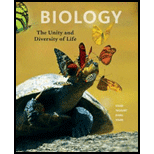
Concept explainers
To explain: The four distinguishing Chordate traits.
Concept introduction: Chordates belong to the Phylum Chordata. The chordates are the highly advanced phylum and includes diverse species with varying adaptations and habitats. Chordates have a notochord, a hollow dorsal nerve cord, pharyngeal slits, an endostyle, and a post-anal tail in their life cycle.
Explanation of Solution
- Notochord
The notochord derived from the mesoderm is present in the anteroposterior axis of the chordates made of a substance similar to cartilage. The notochord is found closer toward the dorsal side than the ventral side. The notochord gives rise to nucleus pulposus of the vertebrae in higher chordates.
- Dorsal tubular nerve cord
Only chordates have dorsal nerve cord that is derived from the ectoderm. The nerve cord during embryonic development later gives rise to the central nervous system during development.
- Pharyngeal gill slits
The invertebrate chordates are filter feeders that feed with the help of pharyngeal gill slits. The pharyngeal gill slits later developed into gills of the aquatic chordates. The higher non-aquatic vertebrates have pharyngeal gill slits during development.
- Post anal tail
Tail is the extension of the body that gives balance for movement. The tail extends beyond the anus and occurs lifelong in most vertebrates. In tailless vertebrates like humans, it occurs during embryonic development.
Want to see more full solutions like this?
Chapter 25 Solutions
Biology: The Unity and Diversity of Life (MindTap Course List)
- What is behavioral adaptarrow_forward22. Which of the following mutant proteins is expected to have a dominant negative effect when over- expressed in normal cells? a. mutant PI3-kinase that lacks the SH2 domain but retains the kinase function b. mutant Grb2 protein that cannot bind to RTK c. mutant RTK that lacks the extracellular domain d. mutant PDK that has the PH domain but lost the kinase function e. all of the abovearrow_forwardWhat is the label ?arrow_forward
- Can you described the image? Can you explain the question as well their answer and how to get to an answer to an problem like this?arrow_forwardglg 112 mid unit assignment Identifying melting processesarrow_forwardGive only the mode of inheritance consistent with all three pedigrees and only two reasons that support this, nothing more, (it shouldn't take too long)arrow_forward
- Oarrow_forwardDescribe the principle of homeostasis.arrow_forwardExplain how the hormones of the glands listed below travel around the body to target organs and tissues : Pituitary gland Hypothalamus Thyroid Parathyroid Adrenal Pineal Pancreas(islets of langerhans) Gonads (testes and ovaries) Placentaarrow_forward
 Biology Today and Tomorrow without Physiology (Mi...BiologyISBN:9781305117396Author:Cecie Starr, Christine Evers, Lisa StarrPublisher:Cengage Learning
Biology Today and Tomorrow without Physiology (Mi...BiologyISBN:9781305117396Author:Cecie Starr, Christine Evers, Lisa StarrPublisher:Cengage Learning Biology: The Dynamic Science (MindTap Course List)BiologyISBN:9781305389892Author:Peter J. Russell, Paul E. Hertz, Beverly McMillanPublisher:Cengage Learning
Biology: The Dynamic Science (MindTap Course List)BiologyISBN:9781305389892Author:Peter J. Russell, Paul E. Hertz, Beverly McMillanPublisher:Cengage Learning Biology (MindTap Course List)BiologyISBN:9781337392938Author:Eldra Solomon, Charles Martin, Diana W. Martin, Linda R. BergPublisher:Cengage Learning
Biology (MindTap Course List)BiologyISBN:9781337392938Author:Eldra Solomon, Charles Martin, Diana W. Martin, Linda R. BergPublisher:Cengage Learning Concepts of BiologyBiologyISBN:9781938168116Author:Samantha Fowler, Rebecca Roush, James WisePublisher:OpenStax College
Concepts of BiologyBiologyISBN:9781938168116Author:Samantha Fowler, Rebecca Roush, James WisePublisher:OpenStax College





